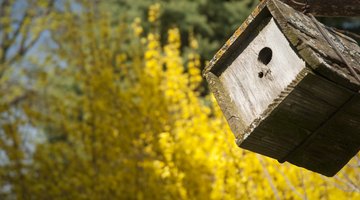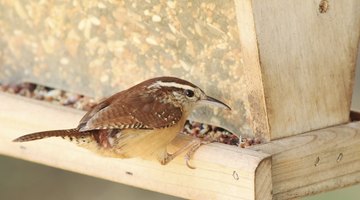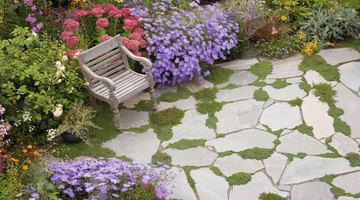How to Attract Wrens to a Garden
Wrens may be small, plain birds, but they still make useful garden companions by keeping insect populations under control while serenading you with song. Commonly spotted species include Carolina wrens and house wrens, both of which have the same requirements for survival.

Attract wrens to your garden by providing them with the basic necessities: shelter, food, protection and water.
Hang Birdhouses

House wrens prefer small spaces and will dwell in birdhouses about 8 inches in height with 4- to 6-inch bases. Entrance holes about 1 inch in width allow small wrens to enter their homes while keeping larger birds out. Hang birdhouses 6 to 10 feet above the ground, attaching them to the branches of small trees. Ensure each birdhouse isn't in direct sunlight and its entrance hole faces away from the prevailing winds.
The ideal birdhouse is made with untreated, rough-sawn wood, preferably cedar or cypress, and features drainage holes on the floor and ventilation holes near the top. Because wrens aren't known for their housekeeping skills, ensure each birdhouse has a simple-to-open top or side so you can keep the interior clean. Removing fallen feathers, old nests and tracked-in dirt after wrens vacate the house will make it a welcoming home for other wrens. Wear work gloves when cleaning a birdhouse, and wash your hands afterward.
Place Bird Feeders

Although wrens will feed on insects and spiders they find in your garden, you can entice them to stick around by providing a supplemental food source. Filling a tub feeder with crushed or whole peanuts and hanging it near a wren birdhouse helps attract wrens, as does placing store-bought suet cakes in a suet bird feeder. Suet is a high-calorie, high-energy food ideal for wrens in winter, but avoid placing it out in hot weather because its fat quickly turns rancid. Peanut butter pudding is a better food choice during the summer months. Make the pudding by combining five parts cornmeal with one part peanut butter. Smear the pudding on a large pine cone, and hang the cone from a low-lying branch. Hanging bird feeders at least 5 feet above the ground prevents hungry dogs from reaching them. Keep the ground beneath feeders clean of peanut shells, dropped food and other waste or else you risk attracting unwanted vermin.
Plant a Bird-Friendly Habitat

Shy wrens are readily attracted to yards with a lot of trees and shrubs with dense undergrowth, which give them places to hide and forage for food. Blackberries (Rubus fruticosus) and American beautyberry (Callicarpa americana) are two shrubs that provide wrens with berries to eat and shady places to loiter. Blackberries are hardy in U.S. Department of Agriculture plant hardiness zones 3 through 9 while beautyberry is hardy in USDA zones 6 through 10. Low-growing perennials attract bugs for the ground-feeding wrens to eat. Two options are chamomile (Chamaemelum nobile) and lady's mantle (Alchemilla mollis), which are hardy in USDA zones 4 through 9 and 3 through 8, respectively. Lady's mantle self-seeds so heavily that it is somewhat invasive, however. Prevent it from self-seeding by removing its spent flower stalks as soon as possible.
If you have room, establish a brush pile in a corner of your garden to provide cover, insects and nesting material for the wrens. Mulching the soil around plants with an organic material attracts insects for your fine-feathered friends to eat. Promote a healthy living area by using herbicides and broad-spectrum insecticides only when absolutely necessary and by following their label directions.
Provide Water

Like other birds, wrens enjoy having a water supply that allows them to quench their thirsts and take refreshing baths. Adding a water source can be as simple as filling a large saucer or inverted garbage can lid with water and placing it on a stump or flat rock, or as complex as adding a pond, water garden or backyard fountain. Many gardeners, however, use a plain, old-fashioned birdbath. Ideal wren birdbaths have gentle slopes and aren't deeper than 3 inches in the center. Don't place a birdbath beneath birdhouses or feeders, or else droppings can contaminate the water. Rinse the birdbath and refill it daily during summer. Check it daily throughout winter to ensure the water is clean and not frozen.
References
- Floridata: Rubus Fruticosus
- Birds and Blooms: Attracting Nesting Birds with Better Birdhouses
- Mother Earth News: Make Your Garden a Bird Habitat
- Birds and Blooms: Carolina Wren
- Clemson Cooperative Extension: Attracting and Feeding Songbirds
- Floridata: Callicarpa Americana
- National Geographic and Complete Birds of North America: House Wren
- University of Florida, Nassau County Extension: Selecting Seeds to Attract Birds
- Missouri Botanical Garden: Chamaemelum Nobile
- Missouri Botanical Garden: Alchemilla Mollis
Resources
Photo Credits
- PaulReevesPhotography/iStock/Getty Images
- PaulReevesPhotography/iStock/Getty Images
- tracy tucker/iStock/Getty Images
- Warren Price Photography/iStock/Getty Images
- Purestock/Purestock/Getty Images
- Bill Stamatis/iStock/Getty Images
More Articles



